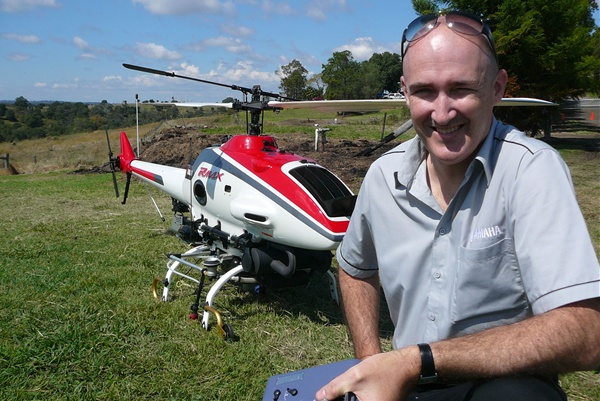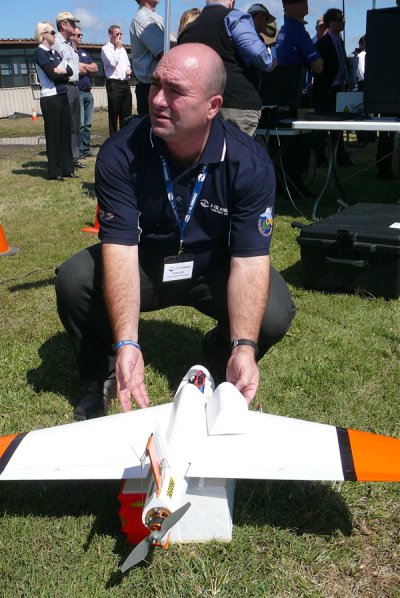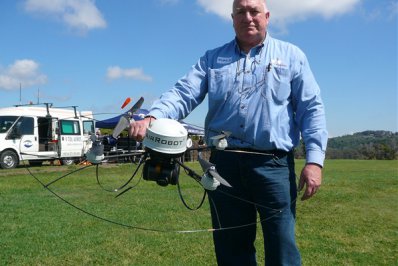- Liam Quigley with Yamaha Rmax
Australian UAS distributors continue to pitch to farmers with flying demonstrations of the latest hardware attracting rural interest at a Marburg field day just west of Brisbane. The deployment of these systems is well documented by the military but the spotlight is now focusing on their relevance to agricultural and horticultural industries where they are poised to become more commonplace down-the-track. Interestingly, Yamaha’s unmanned RMax helicopters buck this trend with the company liaising with the Japanese government to come up with a new way of managing small acreage farms in response to concerns about the country’s ageing rural population.
Such has been the interest in these machines that some 2,400 units are currently operating in the country, according to Yamaha’s (Sky Division) business development manager, Liam Quigley. “Australia is the first major market outside of Japan,” he said. “Applications here will be for ag spraying, also weed control – which will be the big one since the concentration of chemical can be a lot higher, making it a lot more effective,” he added.
As well, the Rmax’s ability to perform in “dirty, dumb and dangerous” situations likely to endanger the life of a pilot looks to be one of its biggest appeals – especially when operating near low-slung power lines.
Yamaha expects interest in Australia to centre on small, steep acreages, also difficult access situations followed by tree crops and coastal spraying programmes. Contractors almost certainly will rent the helicopters from Yamaha since they will be better-placed to maximise their use throughout the year.
Top of mind questions to date have centered on the helicopter’s payload (28kg), also how potential users can access the technology with an on-board GPS ensuring the helicopter can precisely target specific locations. “In terms of cost to run, you are looking at about six litres of two-stroke (fuel) an hour which is pretty spectacular when compared with a manned helicopter,” Liam Quigley said.
COMMENT: By any yardstick this precision engineered Rmax robotic helicopter looks the full-quid with the hand held controls able to direct the unit both forward and rearward across a paddock with pinpoint accuracy.
Meanwhile, V-TOL Aerospace’s delta-winged Warrigal is an unmanned aircraft which is designed and manufactured in Brisbane, weighing in at just 2kg. From a rural perspective, it is attracting interest for its ability to carry miniaturised high resolution video, colour and multi-spectral camera payloads. It is able to take video and high-res still images of crops, terrain and livestock. “We are very happy with its performance to date,” director UAS programmes, Peter Hill said. “This class of UAS is going to be widespread with over 15,000 of these small scale units operating in the US military.”
The point being made here is that a lot of the technology suitable for this platform can be sourced “off-the-shelf” from the computer and mobile phone industries. “This aircraft is at a stage it can be put into a suitcase in the back of a 4WD, making it suitable for widespread use with non-aviation people,” Peter Hill said.
Currently operating with an electric plant, V-TOL says it researching solar and hydrogen fuel cells with University of Queensland. “The sensors are getting smaller and more powerful and with the NBN network roll out it will quite possible for our UAV to be flown in the Northern Territory but be controlled from Brisbane,” Peter Hill said.
Look out for the Warrigal’s multispectral camera which will come into its own by being able to make and analysis of crop canopy, weeds, also assessing the build up of vegetative fuel ahead of the fire season.
COMMENT: Operating at about 30 kph, the Warrigal swooped over and around the field day demonstrating its impressive agility. A plus point looks to be its robust, foam-like construction able to withstand the rigours associated with many farming operations.
While the sci-fi-looking Air Robot attracted the attention of a visiting Queensland Police service representative, there’s no doubt the addition of an ever-burgeoning array of specialist sensors could further broaden its appeal. Company representative Leo King talked up the whisper quiet qualities of its four electrically-powered engines, also the tailor-made aspect of its construction which sees each unit built to meet an individual customer’s preferred specification within six weeks.
COMMENT: The Air Robot is another example of how UAS technology is continuing to emerge at an ever-accelerating rate. Its real-time full motion video with separate data link attracted immense interest on the day, as did its operational stability.
Source: The Land



